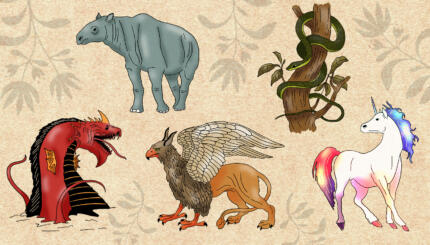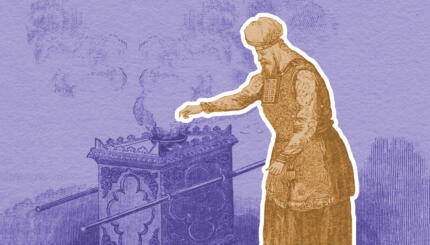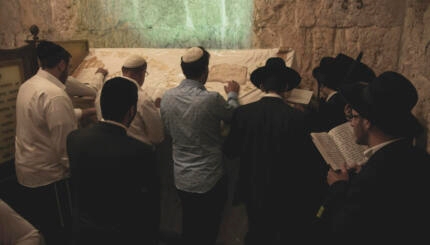What adjectives would you use to describe a Jewish woman? Maybe you would think of your grandmother, your bubbe: loving, worrying, maker of chicken soup. Or if a religious woman comes to mind, maybe modest or passive. Or even the obnoxious Hollywood stereotype: loud and overbearing.
It might surprise you, but the quintessential adjective for a Jewish woman is valor, which the Merriam-Webster dictionary defines as“strength of mind or spirit that enables a person to encounter danger with firmness: personal bravery.”
The text dedicated to honoring the Jewish woman of valor, traditionally sung on Friday night, comes from Chapter 31 of the Book of Proverbs. Its title, Eshet Hayil, means “Woman of Valor.” But the Hebrew word for valor, hayil, can also mean soldier. These two concepts are related. Valor is one of the principal qualities of a soldier. A soldier must be someone with strength of mind and spirit, who can encounter danger with firmness and bravery. But more so, a soldier strives to win a battle while balancing their own needs and those of others. If there is an opportunity to take out an enemy but doing so would expose other soldiers (or innocents) to danger, the needs of the collective must prevail.
Similarly, Eshet Hayil describes a woman who takes care of herself while ensuring that her spouse and children likewise have their needs met. An Eshet Hayil rises in the night to provide for her family. She plants a vineyard and tends to her business. She gives to the poor and oversees the workings of her household. She is trustworthy and a source of stability. Her family praises her.

Help us keep Jewish knowledge accessible to millions of people around the world.
Your donation to My Jewish Learning fuels endless journeys of Jewish discovery. With your help, My Jewish Learning can continue to provide nonstop opportunities for learning, connection and growth.
She looks for wool and flax,
And sets her hand to them with a will.
She is like a merchant fleet,
Bringing her food from afar.
She rises while it is still night,
And supplies provisions for her household,
The daily fare of her maids.
Such a woman, the text tells us, “opens her mouth with wisdom.” She is a woman whose children “stand and rejoice in her,” and who is “clothed in strength and splendor and laughs until her last day.”
The Eshet Hayil, as described in this text, is thus a model for how to achieve to happiness. The Eshet Hayil knows how to care for others while caring for herself. But it takes a little digging underneath the surface to see this.
Consider the verse about wool and flax. On its face, this verse seems to be describing a typical domestic duty in antiquity — the making of fabrics. But the particular materials mentioned, wool and flax, have deeper symbolism.
Wool is soft. It can absorb almost 1/3 of its weight in water. It is an insulating fabric, which makes it popular in winter. When we relate these qualities to emotive attributes, wool is compared to chesed, lovingkindness: Soft, kind, protective, insulating, connective.
Flax is the plant that gives us linen, a durable and tough fabric. It does not stretch and is known to keep one cool when it is hot. So if wool is lovingkindness, flax represents the quality of gevurah, loosely translated as strength. It is often associated with the idea of having boundaries and definition, as opposed to the fluidity associated with lovingkindness.
If we were to summarize the two fabrics, wool is what you wear when it’s cold and you want to retain your heat, while linen is the right choice when it’s hot and you want to stay cool. One attaches to you and insulates, the other detracts and keeps things away.
Both these fabrics have their place. But here’s the catch: There’s a Jewish law known as shatnez that prohibits the wearing of any garment that contains both wool and linen. Just as kosher laws prohibit mixing milk and meat in food, wool and linen cannot be mixed in clothing. Lovingkindness should not be intertwined with the establishing of boundaries.
But there’s an exception: three garments that are not only allowed to have wool and linen mixed, but must have both. The first is the clothing the high priest wore in the Temple in Jerusalem. The second is the tallit, the prayer shawl. And the third is tzitzit, the ritual fringes worn under clothing. All three are considered holy garments. All three have specifications and are required to be worn by Jewish law at certain times. And all have a mixture of wool and linen.
The woman of valor who works with wool and linen is the woman who creates holy garments, the only ones in which these fabrics can be mixed. She understands to mix lovingkindess and boundaries at the proper time, and to keep them separate at others. Sometimes she takes a softer approach, other times a stronger approach. Sometimes the garment is only wool and other times only linen. And most of the time we must ensure they not be mixed. And then there are those special, holy times when they must go together.
A woman who knows when to be fluid and when to be firm, when to exercise lovingkindness and when to establish boundaries, and who recognizes those rare occasions when it’s proper to exhibit both is a woman whose mouth speaks wisdom, whose children celebrate her, and who laughs into age old.



